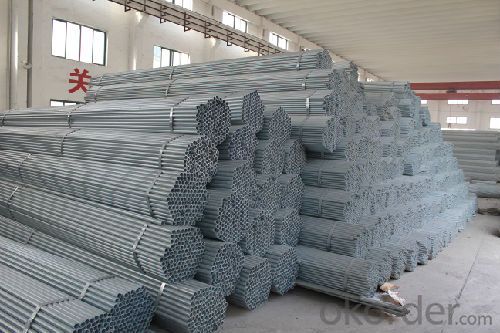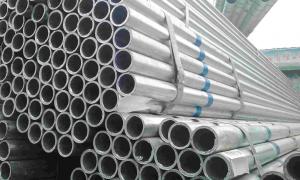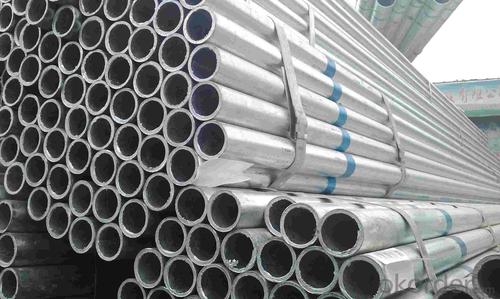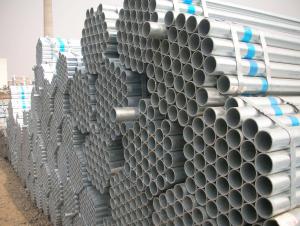America Standard A53 Q215 150g Hot Dipped or Pre-galvanized Pipe
- Loading Port:
- Tianjin
- Payment Terms:
- TT or LC
- Min Order Qty:
- 45 m.t.
- Supply Capability:
- 7000 m.t./month
OKorder Service Pledge
OKorder Financial Service
You Might Also Like
1、Structure of Pre-galvanized Galvanized Pipe America Standard A53 Q215 150g Hot Dipped or Pre-galvanized Pipe:
The surface of Pre-galvanized Galvanized Pipe America Standard A53 Q215 150g Hot Dipped or Pre-galvanized Pipecan increase the corrosion resistance of the steel tube, prolong service life. Galvanized pipe is widely used, in addition to water, gas, oil and other general low pressure fluid pipelines. It is also used in the petroleum industry, especially for offshore oil field of oil well pipe and oil pipe, chemical, coking equipment of oil heater, condensation cooler, coal run oil exchanger tube, and trestle pile, the mine tunnel support frame tube.
2、Main Features of Pre-galvanized Galvanized Pipe America Standard A53 Q215 150g Hot Dipped or Pre-galvanized Pipe:
• High manufacturing accuracy with standard
• High strength and stable
• Good visual effect
• Reasonable price
• Small inertia resistance
• Strong heat dissipation ability
3、Pre-galvanized Galvanized Pipe America Standard A53 Q215 150g Hot Dipped or Pre-galvanized Pipe Specification:
Standard | GB, DIN, ASTM ASTM A106-2006, ASTM A53-2007 |
Grade | 10#-45#, 16Mn 10#, 20#, 45#, 16Mn |
Thickness | 1 - 33 mm |
Section Shape | Round |
Outer Diameter | 21 - 610mm |
Place of Origin | Tianjin, China (Mainland) |
Secondary Or Not | Non-secondary |
Application | Hydraulic Pipe |
Technique | Cold Drawn |
Certification | API |
Surface Treatment | factory state or painted black |
Special Pipe | API Pipe |
Alloy Or Not | Non-alloy |
Length | 5-12M |
Outer Diameter | 21.3-610mm |
Grade | 20#, 45#, Q345, API J55, API K55, API L80, API N80, API P110, A53B |
Standard | ASME, ASTM |
1) Material:20#(ASTM A 106/A53 GRB.API5LGRB,GB),45#,16Mn,10#.
2) Specification range:OD:21.3-610mm,WT:6-70mm,length:6-12m or according to the requirement of clients.
3) Excutive standards:GB,ASME API5L.ASTM A 106/A53,Despite of the above standards,we can also supply seamless steel pipe with standard of DIN,JIS,and so on,and also develop new products according to the requirements of our clients!
4) Surface:black lacquered,varnish coating or galvanized.
5) Ends:Beveled or square cut,plastic capped,painted.
6) Packing:bundles wrapped with strong steel strip,seaworthy packing.
4、Packaging & Delivery
Packaging Details: | seaworthy package,bundles wrapped with strong steel strip |
Delivery Detail: | 15-30days after received 30%TT |
5、FAQ of Pre-galvanized Galvanized Pipe America Standard A53 Q215 150g Hot Dipped or Pre-galvanized Pipe:
①How is the quality of your products?
Our products are manufactured strictly according to national and internaional standard, and we take a test
on every pipe before delivered out. If you want see our quality certifications and all kinds of testing report, please just ask us for it.
Guaranteed: If products’ quality don’t accord to discription as we give or the promise before you place order, we promise 100% refund.
②How about price?
Yes, we are factory and be able to give you lowest price below market one, and we have a policy that “ for saving time and absolutely honest business attitude, we quote as lowest as possible for any customer, and discount can be given according to quantity”,if you like bargain and factory price is not low enough as you think, just don’t waste your time.Please trust the quotation we would give you, it is professional one.
6、 Pre-galvanized Galvanized Pipe America Standard A53 Q215 150g Hot Dipped or Pre-galvanized Pipe: Images:


- Q: Are steel pipes suitable for underground oil pipelines?
- Steel pipes are indeed appropriate for underground oil pipelines. Steel is frequently employed in oil pipelines because of its considerable strength, durability, and resistance to corrosion. Underground oil pipelines encounter different external influences like soil displacement, humidity, and chemicals, but steel pipes can effectively endure these circumstances. Furthermore, by welding steel pipes, a seamless and uninterrupted pipeline can be formed, minimizing the chances of leaks or ruptures. Furthermore, steel pipes have a long history of successful utilization in the oil sector, offering a dependable and cost-efficient method of transporting oil underground.
- Q: How do steel pipes compare to ductile iron pipes?
- Steel pipes and ductile iron pipes are both commonly used in various applications, but they have some differences in terms of their properties and advantages. 1. Strength and Durability: Steel pipes are typically stronger and more durable than ductile iron pipes. Steel has a higher tensile strength, making it less susceptible to cracking or breaking under pressure or external forces. Ductile iron, on the other hand, has a lower tensile strength but has better impact resistance than steel. 2. Corrosion Resistance: Steel pipes are prone to corrosion, especially when exposed to moisture or chemicals. However, they can be protected by applying coatings or using corrosion-resistant alloys. Ductile iron pipes, while inherently more corrosion-resistant than regular cast iron, may still require external protection to prevent rusting and degradation. 3. Flexibility: Ductile iron pipes have greater flexibility than steel pipes. They can withstand certain degrees of bending and deflection without fracturing, making them suitable for applications where ground movement or shifting might occur. Steel pipes are less flexible and more rigid, making them better suited for straight runs or applications with minimal movement. 4. Cost: Generally, ductile iron pipes are more cost-effective than steel pipes. Ductile iron is easier and cheaper to manufacture, resulting in lower production costs. However, steel pipes may have a longer lifespan, requiring fewer replacements over time, which can offset the initial cost difference. 5. Installation: Steel pipes are lighter and easier to handle during installation compared to ductile iron pipes, which can be heavy and bulky. The lighter weight of steel pipes can reduce labor and transportation costs. Additionally, steel pipes can be welded, allowing for more flexible installation options, while ductile iron pipes are typically joined using mechanical couplings or flanged connections. In summary, steel pipes offer superior strength and durability, while ductile iron pipes provide better flexibility and cost-effectiveness. The choice between the two depends on the specific requirements of the application, including factors such as corrosion resistance, expected loads, installation conditions, and budget constraints.
- Q: What is the primary purpose of steel pipes?
- The primary purpose of steel pipes is to transport fluids and gases, such as water, oil, and natural gas, over long distances in a safe and efficient manner.
- Q: How do you calculate the flow rate through a steel pipe?
- To calculate the flow rate through a steel pipe, you need to consider several factors. The most important ones are the diameter of the pipe, the pressure difference across the pipe, and the properties of the fluid flowing through it. Firstly, measure the inside diameter of the steel pipe accurately. This measurement is essential as it determines the cross-sectional area through which the fluid flows. The units for the diameter should be consistent with the units used for other measurements. Next, determine the pressure difference across the pipe. This can be done by measuring the pressure at two points along the pipe, typically at the inlet and outlet. The pressure measurements should be taken at the same height to avoid any discrepancies. The pressure difference is usually given in units of pressure (such as psi, kPa, or bar). Once you have the diameter and pressure difference, you can use the Bernoulli equation or the Darcy-Weisbach equation to calculate the flow rate. The Bernoulli equation relates the pressure difference to the velocity of the fluid. However, this equation assumes ideal conditions, neglecting factors such as friction losses, viscosity, and turbulence. The Darcy-Weisbach equation is more accurate and considers these factors. To use the Darcy-Weisbach equation, you need to know the properties of the fluid flowing through the pipe, such as its density and viscosity. These properties can be determined either through experimentation or by referring to literature values. Once you have all the necessary information, you can use the Darcy-Weisbach equation: Q = (π/4) * D^2 * √[(2 * ΔP) / (ρ * f * L)] Where: Q is the flow rate (in cubic meters per second or any other consistent units) D is the diameter of the pipe (in meters or any other consistent units) ΔP is the pressure difference across the pipe (in Pascals or any other consistent units) ρ is the density of the fluid flowing through the pipe (in kilograms per cubic meter or any other consistent units) f is the friction factor, which depends on the Reynolds number and the roughness of the pipe. L is the length of the pipe (in meters or any other consistent units) By plugging in the values for all the variables, you can calculate the flow rate through the steel pipe accurately.
- Q: Can steel pipes be bent?
- Yes, steel pipes can be bent using specialized tools and techniques such as pipe bending machines or hydraulic benders.
- Q: How are steel pipes used in the construction of stadiums and arenas?
- Steel pipes are commonly used in the construction of stadiums and arenas for various purposes. They are primarily used for structural support, providing a sturdy framework for the buildings. Steel pipes are also used in the installation of plumbing systems, helping to transport water and other fluids throughout the facility. Additionally, steel pipes are utilized for the construction of ventilation and HVAC systems, ensuring proper air circulation and temperature control within the stadiums and arenas.
- Q: Can steel pipes be used for conveying solid materials?
- Yes, steel pipes can be used for conveying solid materials. Steel pipes are known for their high strength and durability, making them suitable for transporting solid materials such as ores, grains, or construction materials. They are commonly used in industries such as mining, agriculture, and construction for this purpose.
- Q: How does galvanization protect steel pipes from corrosion?
- Galvanization protects steel pipes from corrosion by forming a protective zinc coating on the surface of the pipes. This zinc coating acts as a barrier between the steel and the surrounding environment, preventing moisture and corrosive elements from reaching the steel. Additionally, if the zinc coating is damaged, it sacrificially corrodes before the steel, further protecting the pipes from rust and corrosion.
- Q: Are galvanized steel tubes the same as degaussing steel tubes?
- Degaussing steel tubeThe degaussing method specifies the following demagnetization in the established process document
- Q: Are steel pipes suitable for food processing facilities?
- Yes, steel pipes are suitable for food processing facilities. Steel pipes are widely used in the food processing industry due to their numerous benefits. Firstly, steel pipes are highly durable and can withstand high temperatures, pressures, and corrosive substances often used in food processing. This ensures the pipes will not degrade or contaminate the food products. Additionally, steel pipes are easy to clean and maintain, making them ideal for maintaining high levels of hygiene required in food processing facilities. Steel pipes also have excellent resistance to bacteria growth, further ensuring the safety and quality of the food being processed. Furthermore, steel pipes are cost-effective and have a long lifespan, making them a reliable and economical choice for food processing facilities. Overall, steel pipes are a suitable and preferred option for food processing facilities due to their durability, cleanliness, and resistance to contamination.
Send your message to us
America Standard A53 Q215 150g Hot Dipped or Pre-galvanized Pipe
- Loading Port:
- Tianjin
- Payment Terms:
- TT or LC
- Min Order Qty:
- 45 m.t.
- Supply Capability:
- 7000 m.t./month
OKorder Service Pledge
OKorder Financial Service
Similar products
Hot products
Hot Searches
Related keywords
























